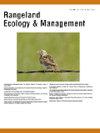Unmanned Aerial Vehicle–Based Remote Sensing of Cattle Dung: Detection, Classification, and Spatial Analysis of Distribution
IF 2.4
3区 环境科学与生态学
Q2 ECOLOGY
引用次数: 0
Abstract
Documenting the distribution of cattle dung across grazed pastures is an important part of understanding nutrient cycling processes in grasslands. However, investigation of distributions at adequate spatial scales and over extended time periods is hindered by the lack of a time- and cost-efficient method for documenting and monitoring dung pat locations. To address this research challenge, an unmanned aerial vehicle and multispectral sensor were used to identify and classify dung pats. Imagery was collected on 12 flights over a subirrigated meadow in the Nebraska Sandhills, in which two different grazing strategies were being evaluated: an ultrahigh stocking density and a low stocking density. The images were classified using supervised classification with a support vector machine algorithm, and post-classification accuracy was assessed using a confusion matrix. In addition, Ripley’s K was used to identify high-density dung areas at varying densities and spatial extents. The classification had an overall accuracy of 82.6% and a Kappa coefficient of 0.71. The user’s accuracy of dung classification was higher (0.91) than the producer’s (0.73). The majority of classification errors were related to the misclassification of dung as vegetation, often in spectrally complex areas where shadowing affected the ability of the classifier to correctly identify dung. Classification accuracy declined precipitously after dung reached 10-14 d of age, both because of the change in spectral reflectance due to drying and because of the regrowth of vegetation. The density-based cluster analysis found no clustering in the low stocking density treatment; dung in the ultra-high stocking density treatment was most frequently found to be clustered near water sources, in corners, and near supplement feeders. This approach to dung identification, mapping, and spatial cluster analysis is a promising alternative to existing methods and deserves further exploration at additional spatial scales and in diverse ecological settings using current technologies.
基于无人机的牛粪遥感:检测、分类与分布空间分析
记录放牧草场中牛粪的分布是了解草地养分循环过程的重要组成部分。然而,在适当的空间尺度和较长的时间内调查分布受到缺乏时间和成本效益的方法来记录和监测粪块位置的阻碍。为了解决这一研究挑战,使用无人机和多光谱传感器对粪块进行识别和分类。在内布拉斯加州沙丘的一个地下灌溉草地上收集了12架飞机的图像,对两种不同的放牧策略进行了评估:超高放养密度和低放养密度。使用支持向量机算法对图像进行监督分类,并使用混淆矩阵评估分类后的准确率。此外,采用Ripley’s K识别不同密度和空间范围的高密度粪区。分类总体准确率为82.6%,Kappa系数为0.71。用户粪分类准确率(0.91)高于生产者粪分类准确率(0.73)。大多数分类错误与粪便作为植被的错误分类有关,通常在光谱复杂的地区,阴影影响分类器正确识别粪便的能力。粪龄达到10 ~ 14 d后,分类精度急剧下降,这既有干燥引起的光谱反射率变化的原因,也有植被再生的原因。基于密度的聚类分析发现,低放养密度处理无聚类;超高放养密度处理的粪便最常聚集在水源附近、角落和补充饲料附近。这种粪便识别、制图和空间聚类分析的方法是现有方法的一个有希望的替代方法,值得在其他空间尺度和利用现有技术在不同的生态环境中进一步探索。
本文章由计算机程序翻译,如有差异,请以英文原文为准。
求助全文
约1分钟内获得全文
求助全文
来源期刊

Rangeland Ecology & Management
农林科学-环境科学
CiteScore
4.60
自引率
13.00%
发文量
87
审稿时长
12-24 weeks
期刊介绍:
Rangeland Ecology & Management publishes all topics-including ecology, management, socioeconomic and policy-pertaining to global rangelands. The journal''s mission is to inform academics, ecosystem managers and policy makers of science-based information to promote sound rangeland stewardship. Author submissions are published in five manuscript categories: original research papers, high-profile forum topics, concept syntheses, as well as research and technical notes.
Rangelands represent approximately 50% of the Earth''s land area and provision multiple ecosystem services for large human populations. This expansive and diverse land area functions as coupled human-ecological systems. Knowledge of both social and biophysical system components and their interactions represent the foundation for informed rangeland stewardship. Rangeland Ecology & Management uniquely integrates information from multiple system components to address current and pending challenges confronting global rangelands.
 求助内容:
求助内容: 应助结果提醒方式:
应助结果提醒方式:


